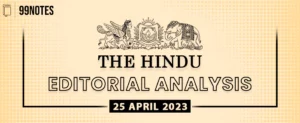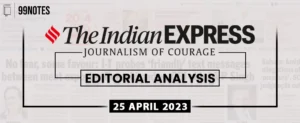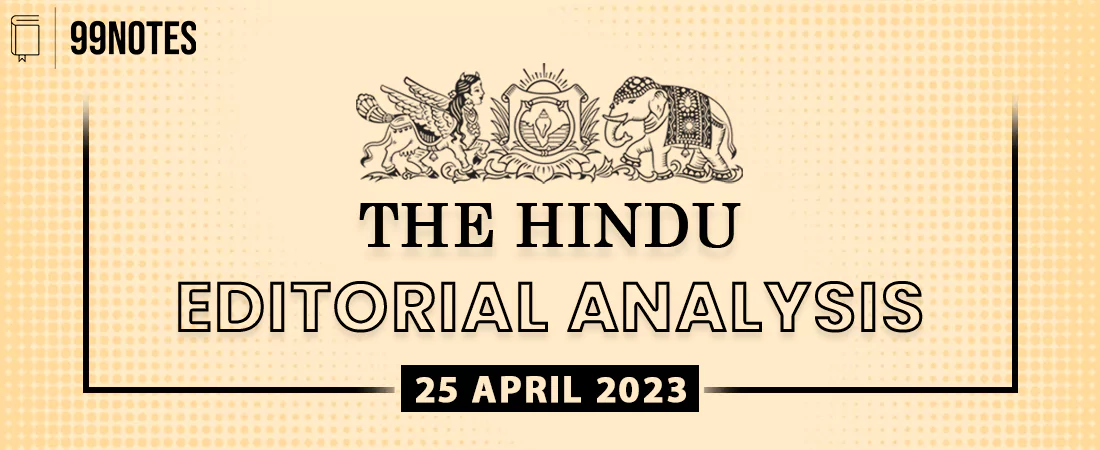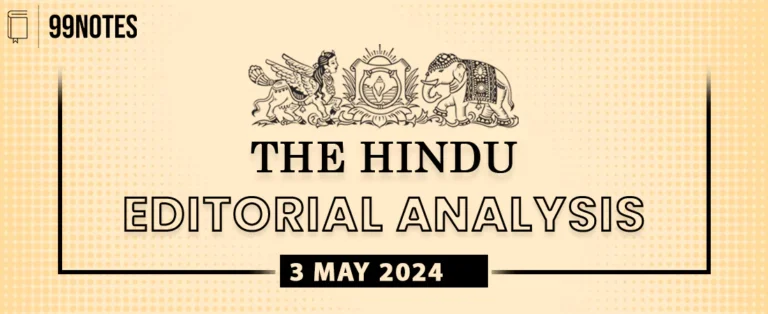26 April 2024 : The Hindu Editorial Notes PDF
The Hindu EDITORIAL
26-April-2024
1. Questioning the polls ‘rain washes out play’ moments
|
Topic: GS2 – Indian polity – Salient features of Representation of People’s Act Critical for UPSC as it evaluates electoral laws, democratic principles, and governance integrity in India. |
| Context: |
| ● The article discusses the legal and democratic implications of unopposed elections in India, highlighting concerns about voter choice and electoral integrity. |
Electoral Laws and Unopposed Elections:
- Rule 11 of the Conduct of Election Rules 1961 allows for the declaration of a candidate as elected unopposed if the number of contesting candidates is equal to or less than the number of seats to be filled.
- Unopposed elections, while legally permissible, raise questions about the democratic process and representation.
Implications of Unopposed Elections:
- Unopposed election victories result in candidates being declared winners without facing any opposition, leading to a lack of choice for voters.
- This phenomenon challenges the essence of democracy, where elected representatives are ideally chosen through a competitive electoral process.
Criticism of Unopposed Elections:
- Critics argue that unopposed elections undermine democratic principles by depriving voters of the opportunity to exercise their right to choose.
- The absence of competing candidates limits the accountability of elected representatives and may lead to complacency in governance.
Role of Electoral Laws and Regulations:
- Section 53 of The Representation of the People Act, 1951 states that if the number of contesting candidates is equal to the number of seats to be filled, all candidates are declared duly elected.
- While this provision is legally valid, it raises concerns about the absence of voter choice and participation.
Challenges with the NOTA Option:
- The introduction of the None of the Above (NOTA) option aimed to empower voters by allowing them to express dissatisfaction with available candidates.
- However, NOTA’s impact on election outcomes is minimal, and it does not effectively address the issue of unopposed elections.
Comparison with Procurement Practices:
- The General Financial Rules (GFRs) provide guidelines for public procurement, emphasising fairness, transparency, and competition.
- While single bids are permissible under certain conditions, lack of competition must not compromise the integrity of the procurement process.
Addressing the Dichotomy in Electoral Processes:
- Unopposed elections highlight a dichotomy between legal compliance and democratic ideals, where candidates can be elected without voter participation.
- There is a need for a broader discussion on electoral reforms to ensure that the democratic process remains robust and inclusive.
Proposed Solutions and Policy Considerations:
- Options for addressing unopposed elections include revising electoral laws to require a minimum percentage of votes for winning candidates or transferring vacant seats to the nominated category.
- These proposals aim to enhance voter participation and strengthen democratic principles in electoral processes.
Conclusion: Ensuring Democratic Integrity:
- Unopposed elections raise significant concerns about democratic representation and voter engagement.
- Addressing this issue requires a comprehensive review of electoral laws and regulations to uphold the integrity and fairness of the electoral process.
- Policy reforms should prioritize empowering voters and promoting competitive elections to sustain democratic values and governance accountability.
| Issues With Unopposed Election |
|
Issues with Unopposed Elections: ● Democratic Deficiency: Unopposed elections deprive voters of the opportunity to exercise their right to choose their representatives, undermining democratic principles. ● Lack of Accountability: Elected representatives in unopposed elections may lack accountability, as they do not face competition and scrutiny from rival candidates. ● Limited Representation: Unopposed candidates may not adequately represent the diverse interests and opinions of constituents, leading to potential marginalisation of certain groups. ● Diminished Public Engagement: Unopposed elections may result in reduced voter turnout and civic engagement, as voters may perceive their participation as futile. ● Potential for Complacency: Unopposed candidates may become complacent in their roles, as they face no electoral challenge or pressure to perform. Way Forward: ● Electoral Reforms: Introduce reforms to discourage unopposed elections, such as requiring a minimum percentage of votes for winning candidates or promoting greater candidate diversity. ● Strengthening Voter Education: Enhance voter education initiatives to increase awareness about the importance of participation in democratic processes and the consequences of unopposed elections. ● Promoting Political Competition: Encourage the emergence of multiple candidates and political parties to foster healthy competition in elections and ensure robust representation. ● Legal Amendments: Amend electoral laws to address loopholes that enable unopposed elections and ensure greater accountability and transparency in the electoral process. ● Civil Society Engagement: Facilitate civil society involvement in monitoring and advocating for fair and competitive elections, holding elected representatives accountable, and promoting voter participation. ● Public Discourse: Encourage public discourse and debate on the implications of unopposed elections, highlighting the need for democratic reforms and citizen engagement in shaping governance. |
| PYQ: To enhance the quality of democracy in India the Election Commission of India has proposed electoral reforms in 2016. What are the suggested reforms and how far are they significant to make democracy successful? (250 words/15m) (UPSC CSE (M) GS-2 2017) |
| Practice Question: Examine the legal and democratic implications of unopposed elections in India, and suggest reforms to enhance electoral integrity. (150 Words /10 marks) |
2. Can green credits benefit India’s forests?
|
Topic: GS2 – Governance – Government policies – Interventions for development in various sectors GS3 – Environment and Ecology – Conservation The Green Credit Programme’s implications for environmental policy, biodiversity conservation, and regulatory compliance are relevant for UPSC exams. |
| Context: |
| ● The article explores India’s Green Credit Programme, critiquing its potential to circumvent forest conservation laws and its impact on biodiversity. |
Introduction:
- The Green Credit Programme, initiated by the Environment Ministry in October 2023, incentivizes environmental contributions through ‘green credits.’
- Critics argue that the program might be exploited to bypass existing forest conservation laws.
Understanding the Green Credit Programme:
- The article portrays the program as a means to incentivize green and sustainable actions by various stakeholders.
- It highlights concerns regarding ground-level execution, emphasizing the need for a broader ecosystem approach beyond mere afforestation.
Concerns about Afforestation:
- Critics raise concerns about potential negative consequences of afforestation, such as monocultures and unsuitable vegetation promotion.
- There is a need to acknowledge the risk and emphasizes the importance of careful implementation to avoid incentivizing monoculture plantations.
Impact on Biodiversity and Ecosystems:
- It emphasises the need to protect existing ecosystems and biodiversity while executing afforestation projects.
- Some criticise past schemes that led to disasters and advocates for natural forest regeneration instead of aggressive plantation drives.Integration with Carbon Markets:
- The article discusses the challenge of measuring diverse environmental impacts and ensuring fungibility within the green credit market.
- It acknowledges the complexity but argues for leveraging private sector resources through market-based incentives.
Challenges with Commensurability:
- There is a need to acknowledge the challenge of equating different environmental credits on the same platform.
- Potential clashes with other environmental laws, such as the Forest Conservation Act.
Implications on Mandatory Compliances:
- Critics raise concerns about the program’s impact on mandatory compliances, particularly forest clearances.
- Warns against compromising environmental principles for the sake of industrial growth.
Clashes with Environmental Laws:
- Clear clashes between the Green Credit Programme and existing environmental legislation, particularly the Forest Conservation Act.
- The program for potentially bypassing crucial environmental clearance processes.
Conclusion:
- The article highlights the complexity of implementing the Green Credit Programme and its potential implications for forest conservation.
- Concerns regarding monoculture, biodiversity loss, and clashes with existing laws underscore the need for careful execution and regulatory alignment.
| The Green Credit Programme |
|
● Green Credit Programme Overview:
● Objectives and Activities:
● Administration and Significance:
● Concerns:
● Way Forward:
|
|
PYQ: (UPSC civil services prelims 2011) Q. Regarding “carbon credits”, which one of the following statements is not correct? (a) The carbon credit system was ratified in conjunction with the Kyoto Protocol (b) Carbon credits are awarded to countries or groups that have reduced greenhouse gases below their emission quota (c) The goal of the carbon credit system is to limit the increase of carbon dioxide emission (d) Carbon credits are traded at a price fixed from time to time by the United Nations Environment Programme. Ans: Option D
Mains: Should the pursuit of carbon credit and clean development mechanism set up under UNFCCC be maintained even through there has been a massive slide in the value of carbon credit? Discuss with respect to India’s energy needs for economic growth. |
| Practice Question: Discuss the potential benefits and challenges of India’s Green Credit Programme in promoting environmental conservation and biodiversity, with reference to regulatory compliance.(250 Words /15 marks) |
For Enquiry

26 April 2024 : Daily Current Affairs Quiz

26 April 2024 : Daily Answer Writing

26 April 2024 : The Hindu Editorial Notes PDF

26 April 2024 : PIB Summary for UPSC

26 April 2024 : Indian Express Editorial Analysis

26 April 2024 : Daily Current Affairs

25 April 2024 : Daily Current Affairs Quiz

25 April 2024 : Daily Answer Writing

25 April 2024 : The Hindu Editorial Notes PDF

25 April 2024 : PIB Summary for UPSC
Daily Quiz 26 April 2024 : Daily Current Affairs Quiz 26- April 2024 : Daily Quiz…
mains answer writing 26 April 2024 : Daily Answer Writing Mains Answer Writing
26-April-2024
Q1) Discuss the multifaceted significance of the fisheries sector…
April 2024 The Hindu Editorial 26 April 2024 : The Hindu Editorial Notes PDF The Hindu EDITORIAL
26-April-2024
1. Questioning the polls ‘rain washes out play’ moments
Topic:…
April 2024 PIB 26 April 2024 : PIB Summary for UPSC PIB Summary for UPSC
26-April-2024
1. Council of Scienific & Industrial Research (CSIR)- National…
April 2024 Indian Express 26 April 2024 : Indian Express Editorial Analysis Indian Express Editorial Analysis
26-April-2024
1. Health on a hot planet
Topic: GS1 – Geography…
April 2024 Daily Current Affairs 26 April 2024 : Daily Current Affairs Daily Current Affairs
26-April -2024- Top News of the Day
1. Ocean floor holds vital clues on weather…
Daily Quiz 25 April 2024 : Daily Current Affairs Quiz 25- April 2024 : Daily Quiz…
mains answer writing 25 April 2024 : Daily Answer Writing Mains Answer Writing
25-April-2024
Q1) What is regenerative agriculture? How is it helpful in addressing…
April 2024 The Hindu Editorial 25 April 2024 : The Hindu Editorial Notes PDF The Hindu EDITORIAL
25-April-2024
1. The Indian seafarer deserves better in choppy high seas
Topic:…
April 2024 PIB 25 April 2024 : PIB Summary for UPSC PIB Summary for UPSC
25-April-2024
1. PM addresses 6th edition of International Conference on Disaster…





